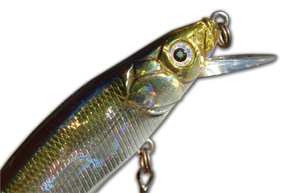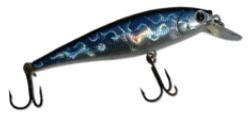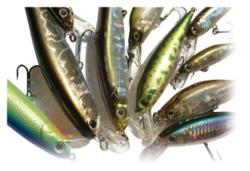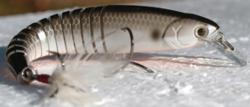Japanese gems
These ornamental imports are alluring to anglers as well as fish

They look like jewelry. They feel like jewelry. They are even priced like jewelry, except these gems have hooks.
For the last five years, Japanese-style lures have been the rage on American bass tours and circuits. Even American lure manufacturers are now producing baits that resemble the ornamental Japanese imports. The Japanese style, characterized by holographic, lifelike finishes and realistic eyes, can be seen in all makes and models of bass lures from top-waters to crankbaits.
So are these Japanese gems designed to catch fish or fishermen?
Although there is much debate over this trend’s proclivity toward fashion rather than function, American bass pros have resoundingly put their stamp of approval on at least one class of Japanese import – the jerkbait.
Japanese versions of the suspending minnow have been infiltrating the bass-fishing underground for a decade. Western anglers have been privy to the foreign fish catchers since the early 1990s, when they started using them on western clearwater impoundments like Lake Mead and Havasu.
Although the Japanese minnows remained a guarded secret among touring pros for a long time, the code was broken in June 1999 at the Forrest Wood Open on Lake St. Clair.
Unbeknownst to many competitors in that event, several top-10 finishers, including Kevin VanDam of Kalamazoo, Mich. (second), and Clark Wendlandt of Cedar Park, Texas (sixth), were quietly introducing giant St. Clair smallmouths to Lucky Craft’s imported Pointer 78.
Not surprisingly, Wendlandt had discovered the Pointer 78 at a tournament on Nevada’s Lake Mead just a few months earlier.
“A Japanese guy staying next to us at Lake Mead gave me a couple of them,” Wendlandt said. “After throwing it a few times, I knew the bait had tremendous potential. I could throw it a mile on a casting rod, and the action was like nothing I had seen before.”
Now Japanese jerkbaits from Team Daiwa, Lucky Craft, Yo-Zuri, Megabass and C’ultiva have earned trays in American tackle boxes right alongside Smithwick, Bomber and Rapala.
When comparing American suspending jerkbaits with their counterparts from Japan, the differences are more than scale-deep.
The lifelike appearances of Japanese jerkbaits are usually what first catch the angling eye. More than a few anglers have discovered the sleek minnows in a tackle store and mumbled, “If I was a bass, I’d have to eat that.”
The detailed finishes and intricate textures captivate anglers until they find the price tag, and then they go into shock. Gems from Japan are hard on the wallet. The average cost of a Lucky Craft, Megabass or Team Daiwa product is between $15 and $20 – for a single bait.
Anglers that brave the sticker shock, however, are rewarded with the first cast. Despite their diminutive size, the Japanese gems cast like rattling lipless crankbaits. They do not roll or “helicopter” with every cast into a stiff breeze.
The next asset an angler is quick to discover is the flashy, erratic action of the impish imports. In the water, the baits look like a minnow or shad having a seizure. The only thing crazier would be a bass for not eating the easy meal.
The castability and deadly action of Japanese jerkbaits come from unique internal weighting systems engineered into the lures. Instead of a fixed weight in the head or belly hook portion of the lure, several metal balls, usually made of brass or tungsten, travel in specific channels or chambers inside the bait so that the inertia of the balls can be utilized most effectively at all times.
When the bait is cast, the dense metallic balls are slung back into the tail of the bait, eliminating the whirly-bird effect and giving it superior castability.
Once the bait touches down and makes its initial descent into the water, the balls roll forward into separate chambers in the belly, evenly distributing the weight along the body for perfect horizontal suspension. Additionally, the balls clatter inside the chambers during the retrieve for noise attraction.
Japanese manufacturers use the terms “weight transfer system” or “weight shifting system” to describe the innovative designs.
VanDam, who is regarded by many to be the top jerkbait technician on tour, gained an appreciation for the sophisticated weight-transfer designs when he began developing a jerkbait.
“What gives the good Japanese jerkbaits such unique action is that they are perfectly weighted along the entire length of the lure,” VanDam said. “That gives it more of a horizontal, side-to-side action instead of a stickier, rolling action produced by jerkbaits that are weighted in the nose.”
The design process took VanDam two years, and it was not easy. Even with the completion of his own jerkbait, he still acknowledges the innovative advancements of some imports.
“I learned a lot about Japanese jerkbaits during that time,” he said. “Jerkbaits are the hardest to design and manufacture. To get a bait that casts well, is balanced and weighted correctly, suspends just right, has the right action, and runs deep is very difficult to do. If you make one tiny change to any aspect of the bait – the size, the lip angle or the weight – it knocks the whole bait out of balance. There are a lot of Japanese-style baits out there now, but in my opinion, there is only a handful that are just right, and the Pointer 78 is one of them.”
Before you go replacing every jerkbait in your tackle box with high-priced Japanese versions, it might be good to hear what American bass pros have to say about their applications.
VanDam totes an arsenal of jerkbaits across the country while on tour. His stock includes a vast assortment of manufacturers, models and sizes. He views Japanese jerkbaits as a tool in the jerkbait genre that serves a specific purpose.
“The small profile and erratic action of a Pointer 78 make it fantastic for warm water,” he said. “But when the water is cold and I want a more sluggish, stickier action, I go back to American jerkbaits.”
Many bass pros have discovered that the flashy, erratic actions of the smaller two-hook models like the Lucky Craft Pointer 78 and the Megabass X-80 are best reserved for warm, clear, open- water situations.
Like VanDam, Kellogg’s pro Wendlandt favors a Pointer 78 (and similar-style Japanese baits) in warm water but says he rarely uses it in water temperatures under 70 degrees.
“The clearer and warmer the water, the more I’ll lean toward the Pointer 78,” he said. “Which is exactly why the bait is so great on Northeast lakes during the summer – those are the best conditions for it. If the water is cold, dingy, or both, I’ll use the big suspending baits like a Husky Jerk or a suspending Rogue.”
Fujifilm pro Randy Blaukat of Lamar, Mo., uses the Megabass X-80 when he wants fast, erratic action in warm, open water. He switches to Megabass’ bigger, more subdued Vision 110 when fishing cooler water.
“The Megabass Vision X-110 has about half the action of the X-80 on the same jerk,” he said. “When the water is cooler in the prespawn and I want a more muted action, I’ll use the X-110. As the water warms up in the postspawn, I like the smaller profile and erratic action of the X-80.”
Wendlandt’s favorite go-to Japanese jerkbait for vegetation is the C’ultiva Rip’N Minnow 90.
“The suspending baits hang up in really shallow grass too much,” he said. “The Rip’N Minnow is a floating shallow diver that has the erratic flash of a Pointer 78, but it doesn’t dig into the grass as bad.”
Jeweler’s tools
One thing that anglers will quickly notice about Japanese jerkbaits is that they are easy to overpower with an aggressive retrieve.
“They don’t need nearly as much snap in the line as a Rogue or Long A to get the same erratic action,” VanDam said. “The harder you work them, the more it deadens the action.”
Working Japanese jerkbaits requires soft, quick jerks with the rod tip. Many pros advise working them similar to a walk-the-dog retrieve used for a top-water stick bait.
“You know how a Zara Spook looks on the surface? That’s the action a Japanese jerkbait will have under the water when you are working it correctly – a frantic, side-to-side darting,” Wendlandt said.
To achieve that action, many pros go to shorter rods with softer tips. Even Wendlandt, who prefers to tweak techniques to the heaviest tackle possible, uses a 6-foot-6-inch lighter-action rod spooled with 10- to 12-pound-test line.
Blaukat represents the lightest end of the tackle spectrum for the delicate baits. He prefers a 6-foot spinning rod with 8-pound-test fluorocarbon line.
“I fish the Megabass X-80 and X-110 on a spinning rod 90 percent of the time,” Blaukat said. “Not only can I cast the bait farther, but I have much better control over the bait’s action and movement with a spinning rod.”
When Blaukat wants to impart the most erratic action possible to an X-80, he uses a radical side sweep with the spinning rod in between twitches to make the bait look like it’s making one last frantic scurry for its life.
“I simply can’t get that same strike-provoking burst from a casting rod,” he said.
When he is using the Megabass Vision X-110 in colder water, he points the rod tip down and gives the bait small twitches during the long pauses between jerks with a very light shake of the rod tip.
“I like a 6-foot pistol-grip casting rod with a soft tip,” he said. “The pistol grip lets me make the short, quick twitches needed to get the bait dancing like a Sammy surface plug.”
Are Japanese-style lures mere costume jewelry? After a decade of mining bass, it looks like Japanese jerkbaits are real gems.
Is the Japanese lure trend going to subside? Not anytime soon. Lucky Craft recently released its Live Pointer 95, a unique lure that has fused the actions of soft-plastic swim baits with that of suspending jerkbaits.
Two other innovative Japanese lure companies to be on the lookout for are Zip Baits and Lake Police Lures.
The numbers name game
If you have shopped for Japanese jerkbaits, you may have noticed many contain numbers in the name. Pointer 78, Flash Minnow 110, X-80, Vision X-110, Staysee 90 – what’s with the numbers?
Since the Japanese use metric units for measure, the numbers refer to the bait’s length in millimeters. Unlike U.S. baits, which are measured in inches, usually 3 to 6 inches, Japanese jerkbaits will run the gamut from 70 to 150 millimeters.


